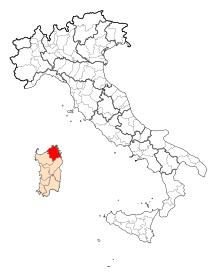| Gymnopilus maritimus | |
|---|---|

| |
| Scientific classification | |
| Domain: | Eukaryota |
| Kingdom: | Fungi |
| Division: | Basidiomycota |
| Class: | Agaricomycetes |
| Order: | Agaricales |
| Family: | Hymenogastraceae |
| Genus: | Gymnopilus |
| Species: | G. maritimus
|
| Binomial name | |
| Gymnopilus maritimus | |

| |
| Gymnopilus maritimus is known only from a localised area in the Province of Olbia-Tempio, Sardinia, Italy.[3] | |
Gymnopilus maritimus is a fungus species of the family Hymenogastraceae first collected in northern Sardinia, Italy, in 2006. The species produces moderately sized, sturdy mushrooms of a reddish-orange colour. The cap, which can measure up to 70 millimetres (3 in) across, is covered in orange fibrils, and sometimes has small scales. The yellowish stem measures up to 110 mm (4 in) in length by 8 mm (0.3 in) in width, and sometimes shows remnants of the partial veil. The mushrooms have thick gills of a variable colour, ranging from yellow to rust but staining darker, and the yellow flesh has a mild taste. The mushrooms leave a rusty-brown spore print, while the spores themselves measure from 7.5–11.5 micrometres (0.00030–0.00045 in) in length. The species is most similar in appearance to G. arenophilus and G. fulgens, but can be differentiated from both morphologically. Despite the similarities, it is not closely related to either, suggesting convergent evolution. Instead, within the genus Gymnopilus, it is most closely related to the spectabilis–imperialis clade. However, it is not particularly similar to any of its closest relatives.
The species has been found only on coastal sand dunes near Olbia, in Sardinia, where it was observed growing at the base of Juncus maritimus (the sea rush), between the winter months of October and January. However, there is speculation that it may also grow elsewhere in Europe. Mushrooms were seen growing from both the sandy soil and decaying plants; however, as a saprotrophic feeder, it is possible that the species would be able to grow on other substrates. The mushrooms grow in close groups or tight tufts.
- ^ "Gymnopilus maritimus Contu, Guzm.-Dáv., A. Ortega & Vizzini". Index Fungorum. Retrieved 27 December 2010.
- ^ "Gymnopilus maritimus Contu, Guzm.-Dáv., A. Ortega & Vizzini 2009". MycoBank. Retrieved 27 December 2010.
- ^ Cite error: The named reference
p200was invoked but never defined (see the help page).